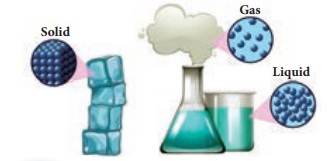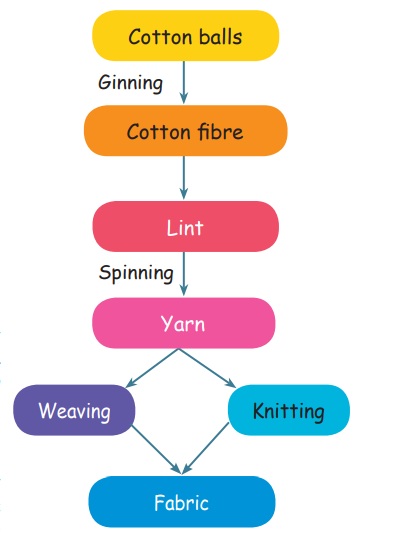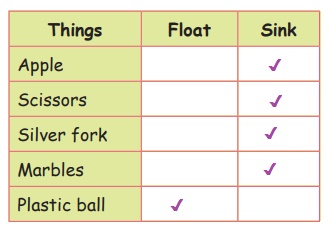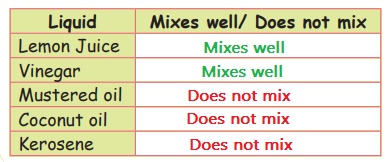Matter and Materials | Term 1 Chapter 2 | 5th Science - Questions with Answers | 5th Science : Term 1 Unit 2 : Matter and Materials
Chapter: 5th Science : Term 1 Unit 2 : Matter and Materials
Questions with Answers
Matter and Materials ( Term 1 Chapter 2 | 5th Science )
Evaluation
I. Choose the correct answer.
1.
Which of the following are the states of matter?
a) Solid, Liquid, Water
b. Solid, Liquid, Gas
c) Solid, Liquid, Wood
d. Solid, Liquid, Sugar
Answer: b. Solid, Liquid, Gas
2.
Which of the following is a solid?
a. Kerosene
b. Air
c. Water
d. Apple
Answer: d. Apple
3.
Jute fibre is obtained from
a. leaf
b. stem
c. flower
d. root
Answer: b. stem
II. Fill in the blanks.
1. Black soil is suitable for growing cotton.
2. The process of making cotton yarn
from cotton fibre is spinning.
3. Ginning is done to separate raw fibres
from the seeds.
4. Synthetic fibre is also called artificial
fibre.
5. Woolen clothes are manufactured from animals
( plant / animals).
III. Match the following.
Yarn - Ginning
Lint - Spinning
Fabrics - Wood pulp
Rayon - Stem
Jute - Weaving
Answer:
Yarn - Spinning
Lint - Ginning
Fabrics- Weaving
Rayon- Wood pulp
IV. Say True or False.
1. Coir is the outer covering of
coconut. (True)
2. Beans and peas are pulses. (True)
3. Table is a household good. (True)
4. Sweet corn is not a product of maize.
(False)
Sweet corn is a product of maize.
5. Cotton balls contain jute fibre. (False)
Cotton balls contain cotton fibre.
V. Complete the given analogy.
1. Solid : Table :: Liquid:
Water
2. Cotton seed : Ginning ::
Lint: Spinning
3. Coir fibre: Coconut ::
Cotton fibre : Cotton Plant
4. Black Pepper: Spice :: Sweat corn : maize product
VI. Answer in brief.
1.
What is known as ginning?
The raw fibres are separated from
the seeds by a process known as Ginning.
2.
Give two examples for food products made from wheat.
Breads, Cakes and Pasta are made
from wheat.
3.
What are synthetic fibres?
These fibres are made by human
beings with the help of chemical process. Hence, they are called synthetic
fibres or manmade fibres.
4.
What is known as upthrust?
When an object is immersed into a
liquid, the liquid exerts an upward force on the object. It is known as
upthrust.
5.
Name the list of whole grains.
Grain is a small, hard, dry seed.
Each grain is protected by a husk and the husk encloses the seed. Two main
types of commercial grain crops are cereals and legumes. Wheat, maize, rice,
beans, peas, barely and millets are some of the whole grains.
VII. Answer in detail.
1.
Discuss briefly about three states of matter.

Solid: In solids molecules are very
closely arranged. Solids are incompressible. They have definite shape, size and
volume.
Liquids: In liquids molecules are
loosely packed. Hence, liquids are negligibly compressible. They have definite
volume, but no definite shape and size.
Gas: In gases, molecules are very
loosely packed. Hence, gases are highly compressible.
2.
Draw a flow chart to indicate the process of making fabrics from cotton ball.
The fibrous material left after
separating cotton seeds is called lint. The lint is then tied and pressed into
balls. The final proportions of short fibres and other impurities are removed
by the process of combing.

Spinning : The process of making yarn
from lint (fibre) is called spinning. Spinning is done on a large scale with
the help of spinning machines.
Yarn to fabrics : Weaving and knitting are the two most important processes used for making fabric from the yarn. The process of making two sets of yarns together to make fabric is called weaving. It is done by weavers on a machine called loom. The looms are either hand - operated (hand looms) or power - operated. During knitting a single yarn is used to make a piece of fabric. It is done by hand and also on machine.
VIII. Give reason.
1.
Why umbrellas are made up of synthetic clothes?
Synthetic clothes have greater
hydrophobic quality (water repelling quality) but natural fibres absorb water
more easily. Synthetic clothes do not absorb water and so umbrellas are made up
of synthetic clothes.
2.
What determines whether an object floats or sinks in a fluid?
When the weight of an object is
greater than the upthrust of the fluid it sinks into it.
When the weight of an object is less
than the upthrust of the fluid it floats on the fluid.
Activity 1
Look at your surrounding. Give some examples for solids, liquids and gases. Solids Liquids gases

Activity 2
Classify the following natural fibres. Polyster, Jute, Silk, Nylon, Cotton, Wool, Acrylic, Rayon.

Activity 3
Take water in a bucket and drop the following items in the water.
Apple, Scissors, Silver fork, Marbles, Plastic ball.
Fill the table with your observation.

Activity 4
Collect some samples of solid substances such as salt, sugar, chalk powder, sand and saw dust.
Take five beakers filled with water and add a small amount of sugar to the first beaker, salt to the second and similarly, add small amounts of other substances in other beakers. Stir the content with a glass rod. Wait for few minutes. What happens to the substances added? Note your observation.

Activity 5
Collect samples of coconut oil, kerosene, mustard oil, lemon juice and vinegar. Take five test tubes, fill them up to half with water. Add a spoon full of one liquid to this and stir it well. Keep it in a test tube stand and wait for few minutes. Observe whether the liquid mixes with water. Repeat the experiment with other liquids and tabulate your observation.

Related Topics